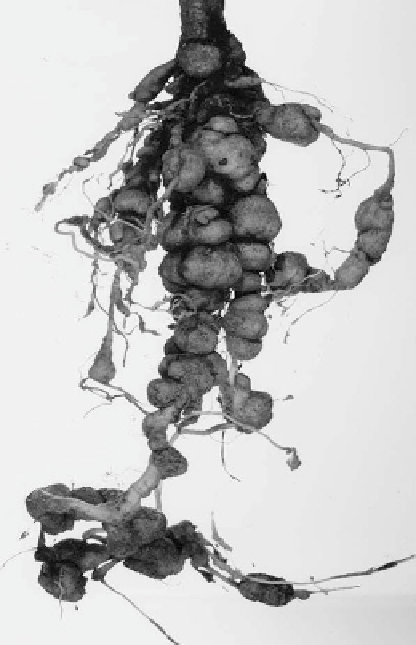Biology Reference
In-Depth Information
have been developed resistant to particular spe-
cies. Soil fumigation before planting is a common
control; see chapter
Introduction for satisfac-
tory chemicals. These usually kill larvae free in
the soil but not all of those inside root knots.
Meloidogyne arenaria
Root-Knot Nematode
.
Causes stunting and root gall on dwarf gardenia,
compacta holly, and japanese boxwood. Also
reported on watermelon.
Meloidogyne arenaria (formerly
Meloidogyne
arenaria thamesi
).
Thames' Root-Knot Nema-
tode
. Occurring naturally in Florida, on Chinese
silk-plant (Boehmeria); found elsewhere in
greenhouses. Also reported on tomato and
scindapsus.
Meloidogyne
▶
arenaria
thamesi (see
Meloidogyne arenaria
).
Thames' Root-Knot
Nematode
.
Meloidogyne chitwoodi
Columbia Root-Knot
Nematode
. Has been associated with alfalfa,
potato, tomato, sugar beet, wheat, and corn.
This is significant because wheat and corn are
commonly grown in rotation with potato and
sugar beets to reduce
M. hapla
. Both monocoty-
ledonous and dicotyledonous plant species are
good hosts, indicating a wide host range for this
nematode.
Meloidogyne graminicola
Rice Root-Knot
Nematode
. On purple nutsedge and yellow nut-
sedge.
Root-Knot Nematode
on clovers.
Meloidogyne hapla
Northern Root-Knot Nem-
atode
. Common on many outdoor crops in the
North and in florist and nursery stock. Hosts
include abelia, anoda, barberry, bean, blueberry,
boxwood, California-laurel, cantaloupe, carrot,
cherry, clematis, clovers, cocklebur, corn, cress,
cucumber, dog fennel, eggplant, escarole, for-
sythia, geranium, germander, gladiolus, grape-
hyacinth, goldenchain, jimsonweed, kale, lettuce,
marigold, mock-orange, morning-glory, mul-
berry, myrtle, mustard, parsnip, pachysandra,
pansy, peanut, peony, pepper, periwinkle,
potato, privet, rose, sainfoin, sequoia, soybean,
spirea, spurge, strawberry, sugar beet, tomato,
velvetleaf, viburnum, wheat, and weigela.
This species is a particular pest of peanut and
is probably the most important nematode on
strawberries. It causes galls, reduces growth of
▶
Fig. 4
Root-Knot Nematode; pear-shaped female with
egg sac; encysted young larva; and wormlike adult male
naked eye. The male changes into a threadlike
cylindrical form, folded up inside the larval molt,
from which it finally escapes.
The female deposits its eggs in an extruded
yellow-brown jelly. There may be up to 3000; the
average is nearer 300 to 500. The larvae develop
inside the eggs and become free in the soil when
the host root cracks or decays. They may attack
the same root in a new place or another root. At
80
F a generation takes only 25 days; at 67
F the
cycle averages 87 days, and below 55
F activity
ceases. Root-knot nematodes may be injurious
by their feeding punctures even if typical swell-
ings are not formed. Some have been shown to
increase Fusarium and bacterial wilts, and
they almost surely complicate the crown-gall
problem.
Control
Rotation of crops may be practical only
for species with a narrow host range, and a few
varieties of vegetables, fruits, and ornamentals


